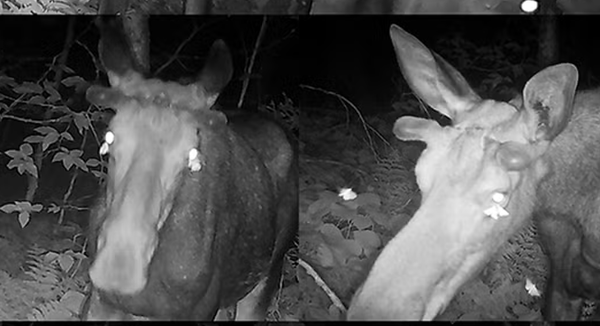At 23 years old she became the queen of a mountain kingdom

From Wikipedia: "In 1959, Hope Cooke was a freshman majoring in Asian Studies at Sarah Lawrence College. She went on a summer trip to India and met Palden Thondup Namgyal, Crown Prince of Sikkim. He was a 36 year-old recent widower with two sons and a daughter. Two years later, in 1961, their engagement was announced, but the wedding was put off for more than a year because astrologers in both Sikkim and India warned that 1962 was an inauspicious year for marriages. After the wedding she became the Queen Consort to the 12th and last King of Sikkim. In 1975 Namgyal was deposed and Sikkim merged into India as a result of internal turmoil, Indian military intervention and a referendum. Cooke returned to the US and began a career as a lecturer, book critic, and newspaper columnist for the Daily News."
In the early 1900s a famous art historian wrote about how he was turning into a werewolf

From Public Domain Review: "Wholly oblivious to any and all of the festive sacred and secular celebrations of the day, or even to it being St. Michael’s Day, Hamburg-born art historian Aby Warburg sat at his desk in his brightly lit apartment in the Bellevue Sanatorium. Discouraged and frustrated by the previous seventeen-month succession of fruitless therapies, medical director Dr. Ludwig Binswanger had suggested to Warburg that the composition of an anamnesis — a biographical account of his illness — might help heal his troubled body and soul. On the morning after composing the anamnesis, before the onset of the very same daily psychotic attacks that he had been enduring for four years, he wrote to his wife Mary, lamenting that his situation had returned to that of the fall of 1918, as he writes about again reverting to being a werewolf."
She got a phone bill for $11 quadrillion dollars and the company refused to change it

From Now I Know: "In 2012, San Jose was living in Pessac, a commune of about 65,000 people not too far from Bordeaux. But she had fallen on hard times — she had recently lost her job and was looking to make ends meet. She called the phone company, Bouygues Telecom, and asked them to close her account. No problem, they told her —they’d just need to send her a bill for the amount still owed on the account. When the bill arrived, San Jose said she almost had a heart attack there were so many zeroes — a dozen of them, behind an 11 and a 721. In total, Bouygues Telecom billed her for €11,721,000,000,000,000 (or €11.721 quadrillion) to be exact. So San Jose called Bouygues Telecom to tell them there was, obviously, a mistake. And Bouygues Telecom told her, no, the fee was as demanded. San Jose called back in hopes of getting a more reasonable customer service agent, but again,was only offered a payment plan."
Hi everyone! Mathew Ingram here. I am able to continue writing this newsletter in part because of your financial help and support, which you can do either through my Patreon or by upgrading your subscription to a monthly contribution. I enjoy gathering all of these links and sharing them with you, but it does take time, and your support makes it possible for me to do that. I also write a weekly newsletter of technology analysis called The Torment Nexus.
For most of the last 80,000 years tomatoes were the size of blueberries and often poisonous

From Works in Progress: "The wild ancestors of today’s tomatoes were much smaller than their modern-day counterparts and grew in sprawling patterns, making them ill-suited to large-scale agriculture. Nearly 80,000 years ago, Central and South America were home to a blueberry-sized plant called Solanum pimpinellifolium – the ancestor of modern tomatoes. Wild descendants of this plant can still be eaten today but are more labor-intensive to pick and less versatile in the kitchen than their domesticated cousins. Some varieties are also toxic to humans. Native Americans recognized the utility of having a larger, safer plant and began breeding accordingly. By roughly 7000 years ago they had created precisely this: Solanum lycopersicum, the common tomato."
Researchers say spores from fungi can survive up to ten kilometers above the earth's surface

From Science: "Scientists report that they have captured fungal spores cruising in the inhospitable environment of the stratosphere, much higher than commercial aircraft can fly. When these spores have been brought back to the lab, the researchers found that some of the spores — including pathogens of plants and people — had survived intercontinental trips and could be cultured in the lab. Although spores and microbes have been detected in the stratosphere before, the new results come from a cheap, homespun sampling device dangled from weather balloons. More regular sampling could help researchers figure out what traits and conditions allow spores to survive in the stratosphere and how they get up there in the first place. The work could also be a first step toward a monitoring system that could nip emerging fungal pathogens in the bud."
There's a cafe in Tokyo where you can pet capybaras
A cafe in Tokyo where you can pet Capybaras
— Science girl (@gunsnrosesgirl3) May 7, 2025
📹 space_tamnik
pic.twitter.com/dYzAIT5ugd
Acknowledgements: I find a lot of these links myself, but I also get some from other newsletters that I rely on as "serendipity engines," such as The Morning News from Rosecrans Baldwin and Andrew Womack, Jodi Ettenberg's Curious About Everything, Dan Lewis's Now I Know, Robert Cottrell and Caroline Crampton's The Browser, Clive Thompson's Linkfest, Noah Brier and Colin Nagy's Why Is This Interesting, Maria Popova's The Marginalian, Sheehan Quirke AKA The Cultural Tutor, the Smithsonian magazine, and JSTOR Daily. If you come across something interesting that you think should be included here, please feel free to email me at mathew @ mathewingram dot com



